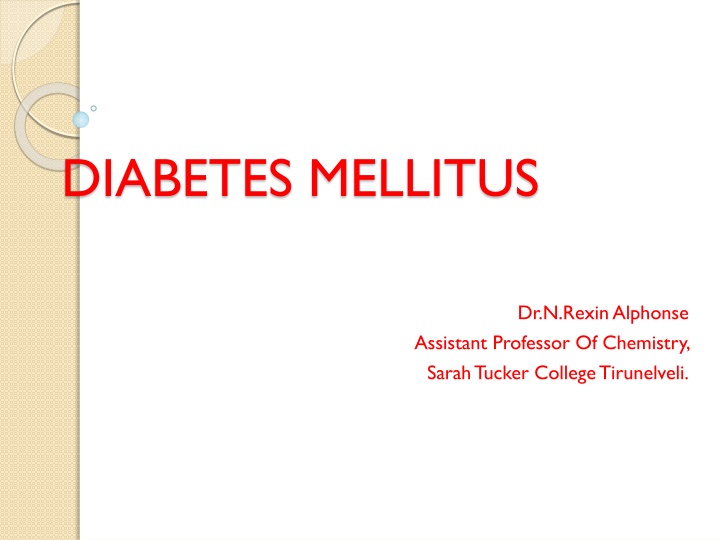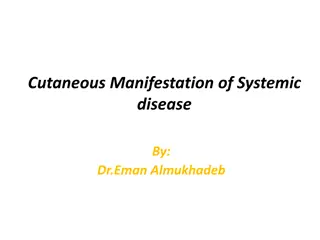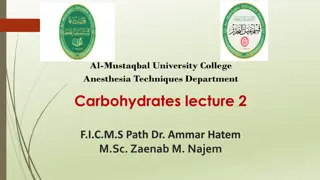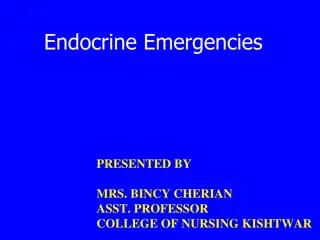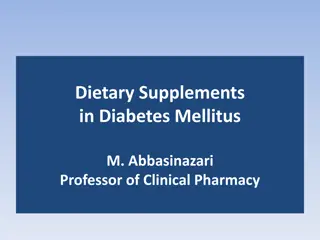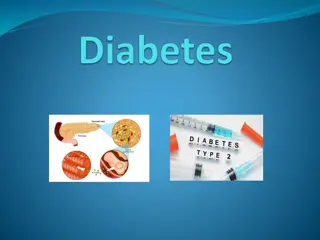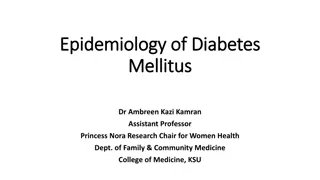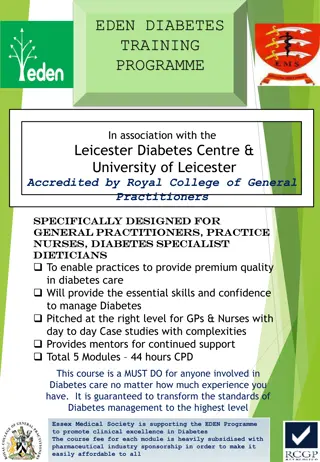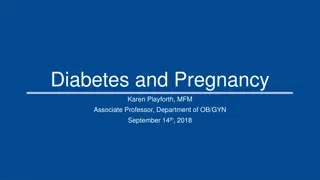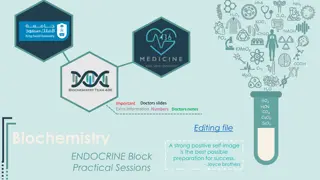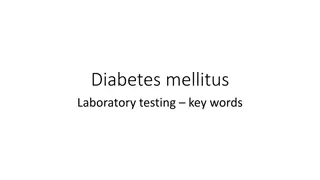DIABETES MELLITUS
Diabetes mellitus is a condition characterized by metabolic disorders and hyperglycemia, resulting from insulin deficiency or resistance. The three main forms recognized by the WHO are Type 1, Type 2, and Gestational Diabetes. Each type has distinct characteristics, symptoms, and long-term complications that can impact overall health. Proper management through medication, lifestyle changes, and regular monitoring is crucial in controlling diabetes and preventing severe complications.
Download Presentation

Please find below an Image/Link to download the presentation.
The content on the website is provided AS IS for your information and personal use only. It may not be sold, licensed, or shared on other websites without obtaining consent from the author.If you encounter any issues during the download, it is possible that the publisher has removed the file from their server.
You are allowed to download the files provided on this website for personal or commercial use, subject to the condition that they are used lawfully. All files are the property of their respective owners.
The content on the website is provided AS IS for your information and personal use only. It may not be sold, licensed, or shared on other websites without obtaining consent from the author.
E N D
Presentation Transcript
DIABETES MELLITUS Dr.N.RexinAlphonse Assistant Professor Of Chemistry, Sarah Tucker College Tirunelveli.
INTRODUCTION Introduction. Diabetes mellitus is a syndrome characterized by disordered metabolism and hyperglycemia resulting from either low levels of insulin or abnormal resistance to insulin. Insulin. Insulin is an important hormone that regulates the uptake of glucose from blood into cells. Insulin is released into the blood by beta cells (found in the islets of langerhans in pancreas) in response to rising levels of blood glucose. The deficiency of insulin or insensitivity of its receptors plays an important role in all forms of diabetes mellitus.
The World Health Organization (WHO) recognizes three main forms of diabetes Type 1 Diabetes Mellitus It is usually due to autoimmune destruction of pancreatic beta cells. Type 2 Diabetes Mellitus It is characterized by insulin resistance or insulin insensitivity, combined with reduced insulin secretion. Gestational Diabetes Mellitus. It occurs in about 2 5% of pregnant women and may improve or disappear after delivery
Type 1 Diabetes Mellitus. It is usually due to autoimmune destruction of pancreatic beta cells. It is characterized by the loss of insulin producing beta cells of islets of langerhans in the pancreas. Type 1 diabetes often occurs in children and young adults. Individuals with Type 1 must take insulin throughout their life, failure of which can develop diabetic ketoacidosis that may lead to coma or even death. Symptoms. Polyurea, nausea, vomiting, blurred vision, excessive fatigue, weight loss, abdormal pain and ketoacidosis
Type 2 Diabetes Mellitus Type 2 diabetes is characterized by insulin resistance or insulin insensitivity, combined with reduced insulin secretion. It occurs in people who are overweight, inactive and older than 40 years. Non Insulin Dependent Diabetes Mellitus (NIDDM). It can be treated by increasing physical activity, decreasing carbohydrate intake and by oral antidiabetic drugs. Symptoms Renal failure due to diabetic nephropathy, vascular disease, vision damage due to diabetic retinopathy, loss of sensation due to diabetic neuropathy, and liver damage are some of the long term complications.
Gestational Diabetes Mellitus. Gestational diabetes resembles Type 2 diabetes. It occurs in about 2 5% of pregnant women and may improve or disappear after delivery Gestational diabetes is fully treatable. About 20 50% of affected women develop Type 2 diabetes later in life. Untreated gestational diabetes can damage the health of the fetus or mother Risk to the baby include Macrosomia (high birth weight) Congenital cardiac and central nervous system Skeletal malformations
Treatment For Diabetes Mellitus Various oral antidiabetic drugs (Type 2), insulin (Type 1), bio artificial pancreas, islet cell transplantation approach, stem cell approach, gene therapy approach and nanotechnology approach are available.
REFERENCE 1.Maurya R.C., Mishra D.D., Awasthi S.,, Mukherjee S., Syn and Reat Inorg, Metal-Org, and Nano-Metal Chem, 1991, 21, 1447 - 1456 2. Sumita Rao N., Mishra D.D., Maurya R.C., Nageswara Rao N., Syn and 3.Reat Inorg, Metal-Org, and Nano-Metal Chem, 1995, 25, 437 - 449 4.Yonghua Huang., Haoyu Shen., and Shu Long., Syn and Reat Inorg, Metal- 5.Org, and Nano-Metal Chem, 2002, 32, 1611 1624. 6.Maurya R.C., Mishra D.D. , Dubey J., Syn and Reat Inorg, Metal-Org, and Nano-Metal Chem, 1994, 24, 1805 - 1816 7.Lenny C.Y. Woo., Violet G. Yuen. , Katherine H. Thompson ., John H. 8.Debbie C. Crans., Hartmut Hoist., Anastasios D. Keramidas., Dieter Rehder., Inorg. Chem. 1995, 34, 2524-2534 9.Katherine H. Thompson., John H. McNeill., and Chris Orvig., Chem. Rev. 1999, 99, 2561-2571 10.Syamal A., Maurya M.R.,Dooms E., McLean J.A., Synthesis and Reactivity In Inorganic, Metal-Organic, and Nano-Metal Chemistry 1986, 16, 39 - 60
